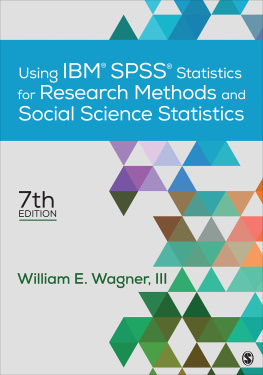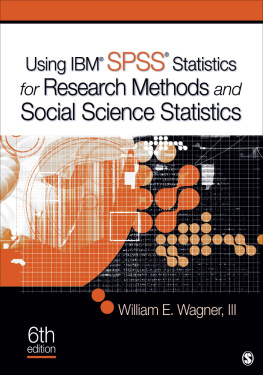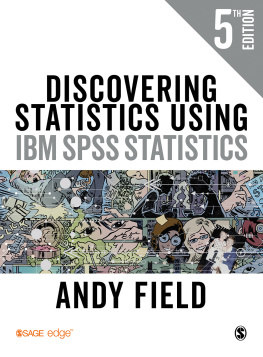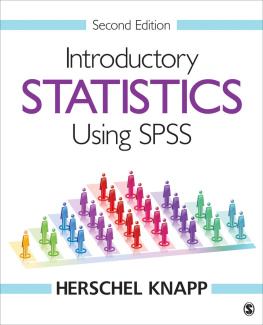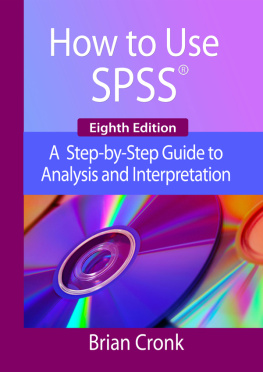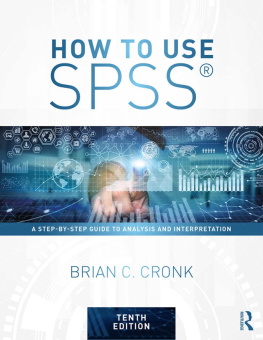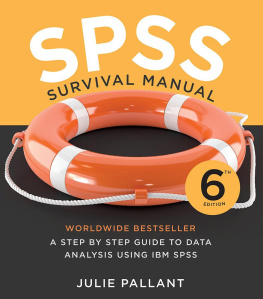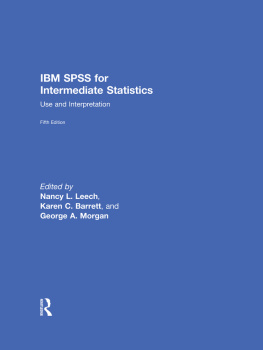FOR INFORMATION:
SAGE Publications, Inc.
2455 Teller Road
Thousand Oaks, California 91320
E-mail: order@sagepub.com
SAGE Publications Ltd.
1 Olivers Yard
55 City Road
London EC1Y 1SP
United Kingdom
SAGE Publications India Pvt. Ltd.
B 1/I 1 Mohan Cooperative Industrial Area
Mathura Road, New Delhi 110 044
India
SAGE Publications Asia-Pacific Pte. Ltd.
18 Cross Street #10-10/11/12
China Square Central
Singapore 048423
Copyright 2020 by SAGE Publications, Inc.
All rights reserved. Except as permitted by U.S. copyright law, no part of this work may be reproduced or distributed in any form or by any means, or stored in a database or retrieval system, without permission in writing from the publisher.
All third party trademarks referenced or depicted herein are included solely for the purpose of illustration and are the property of their respective owners. Reference to these trademarks in no way indicates any relationship with, or endorsement by, the trademark owner.
SPSS is a registered trademark of International Business Machines Corporation.
Printed in the United States of America
Library of Congress Cataloging-in-Publication Data
Names: Wagner, William E. (William Edward), author.
Title: Using IBM SPSS statistics for research methods and social science statistics / William E. Wagner, III, California State University, Channel Islands.
Description: Seventh edition. | Los Angeles : SAGE, [2020] | Includes bibliographical references and index
Identifiers: LCCN 2018050720 | ISBN 9781506389004 (pbk. : alk. paper)
Identifiers: LCCN 2018050719 | ISBN 9781544302072 (hardcover : alk. paper)
Subjects: LCSH: Social sciencesStatistical methods. | SPSS for Windows.
Classification: LCC HA32 .W34 2020 | DDC 300.285/555dc23 LC record available at https://lccn.loc.gov/2018050720
This book is printed on acid-free paper.
Typesetter: C&M Digitals (P) Ltd.
Preface
This book was written for those learning introductory statistics or with some basic statistics knowledge who want to use IBM SPSS Statistics software to manage data and/or carry out basic statistical analyses. It can also be a useful tool to gain an understanding of how SPSS Statistics software works before going on to more complicated statistical procedures. This volume is an ideal supplement for a statistics or research methods course. Although it can be used with any research methods or statistics book or materials, this book was tailored to complement all editions of Investigating the Social World, by Russell K. Schutt, and Social Statistics for a Diverse Society, by Chava Frankfort-Nachmias and Anna Leon-Guerrero (latest editions published in 2018 and 2017, respectively). It can also be used as a guide for those working with basic statistics on their own. The book provides information for users about some of the important mechanics of SPSS Statistics operating procedures for simple data management along with accessible introductory instructions to statistical operations.
References
Frankfort-Nachmias , C. , & Leon-Guerrero , A. ( 2017 ). Social statistics for a diverse society ( 8th ed.). Thousand Oaks, CA : SAGE .
Schutt , R. K. ( 2018 ). Investigating the social world: The process and practice of research ( 9th ed.). Thousand Oaks, CA : SAGE .
IBM SPSS Statistics was formerly called PASW Statistics. SPSS is a registered trademark of International Business Machines Corporation
Acknowledgments
The author and SAGE gratefully acknowledge the contributions of the following reviewers:
- James A. Bernauer, Robert Morris University
- Adam Faight, Porter and Chester Institute
- Martonia Gaskill, PhD, University of Nebraska at Kearney
- Robin Hernandez-Mekonnen, Stockton University
- Cheng-Hsien Lin, Lamar University
- Kristen Linton, California State University, Channel Islands
- Randolph Merced, Rosemont College
- Jingjing Niu, Idaho State University
- Angela Taylor, Fayetteville State University
- Kyle M. Woosnam, PhD, University of Georgia
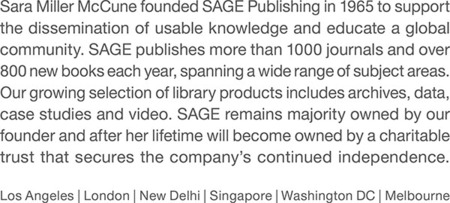
Chapter 1 Overview
This book serves as a guide for those interested in using IBM SPSS Statistics software to assist in statistical data analysiswhether as a companion to a statistics or research methods course, a stand-alone guide for a particular project, or an aid to individual learning. The images and directions used in this book come from IBM SPSS Statistics Version 25.0, first released during the summer of 2018. If you are using IBM SPSS Statistics Version 24, you will notice considerable consistency. For anyone using SPSS Version 23, 22, 21, or 20, or even PASW Statistics 18 or earlier, there will be a great deal of consistency with these instructions and images, although there will be some areas where there are differences due to the upgrades in the SPSS Statistics Version 25 software. So, the older your version of SPSS Statistics (or even PASW Statistics), the more likely you will see some differences in methods, availability of options, screen views, and output format.
Whats the Difference Between SPSS Statistics and PASW Statistics? None.
There is essentially no difference. The program formerly known simply as SPSS became SPSS Statistics with the Version 17.0 release, and then PASW Statistics with the Version 18.0 release. After SPSS, Inc., became an IBM company in October 2009, the branding going forward was changed so that future releases of the software (Version 19.0 and beyond) are known as IBM SPSS Statistics. When SPSS was originally developed, it stood for Statistical Package for the Social Sciences. The motivation for the PASW (Predictive Analytics Software) branding change was to reflect the considerable reach of the software to more business-oriented realms, although now as it stands in history, this name was used only for Version 18.

